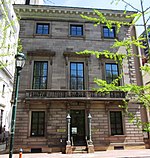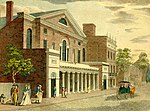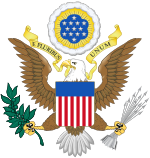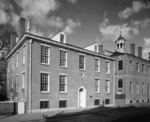The Constitutional Convention took place in Philadelphia from May 25 to September 17, 1787. Although the convention was intended to revise the league of states and first system of government under the Articles of Confederation, the intention from the outset of many of its proponents, chief among them James Madison of Virginia and Alexander Hamilton of New York, was to create a new Frame of Government rather than fix the existing one. The delegates elected George Washington of Virginia, former commanding general of the Continental Army in the late American Revolutionary War (1775–1783) and proponent of a stronger national government, to become President of the convention. The result of the convention was the creation of the Constitution of the United States, placing the Convention among the most significant events in American history.
The convention took place in the old Pennsylvania State House (now known as Independence Hall) in Philadelphia. At the time, the convention was not referred to as a constitutional convention. It was contemporarily known as the Federal Convention, the Philadelphia Convention, or the Grand Convention at Philadelphia. Nor did most of the delegates arrive intending to draft a new constitution. Many assumed that the purpose of the convention was to discuss and draft improvements to the existing Articles of Confederation, and would not have agreed to participate otherwise. Once the convention began, however, most of the delegates – though not all – came to agree in general terms that the goal would be a new system of government, not simply a revised version of the Articles of Confederation.
Several broad outlines were proposed and debated, most notably Madison's Virginia Plan and William Paterson's New Jersey Plan. The Virginia Plan was selected as the basis for the new government, and the delegates quickly reached consensus on a general blueprint of a federal government with three branches (legislative, executive, and judicial) along with the basic role of each branch. However, disagreement over the specific design and powers of the branches delayed progress for weeks and threatened the success of the convention. The most contentious disputes involved the legislature, specifically the composition and election procedures for the Senate as the upper legislative house of a bicameral Congress, and whether proportional representation was to be defined by a state's geography or by its population. The role of the executive was also hotly debated, including the key issues of whether to divide the executive power among three people or vest the power in a single chief executive to be called the President; how a president would be elected; the length of a presidential term and the number of allowable terms; what offenses should be impeachable; and whether judges should be chosen by the legislature or the executive. Finally, slavery was also a contentious issue, with the delegates debating the insertion of a fugitive slave clause; whether to allow the abolition of the slave trade; and whether slaves were to be counted in proportional representation. Most of the time during the convention was spent on deciding these issues.
Progress was slow until mid-July, when the Connecticut Compromise resolved enough lingering arguments for a draft written by the Committee of Detail to gain acceptance. Though more modifications and compromises were made over the following weeks, most of this draft can be found in the finished version of the Constitution. After several more issues were debated and resolved, the Committee of Style produced the final version in early September. It was voted on by the delegates, inscribed on parchment with engraving for printing, and signed by 39 of 55 delegates on September 17, 1787. The completed proposed Constitution was printed in several copies for review which began the debates and ratification process. Soon after it was also printed in newspapers for public review.










